Mr. H. Gossen, a German economist, was the first to explain this law in 1854. Alfred Marshall later restated this law in the following words: “The additional benefit which a person derives from an increase of his stock of a thing diminishes with every increase in the stock that already has.”
Law is based on Three Facts:
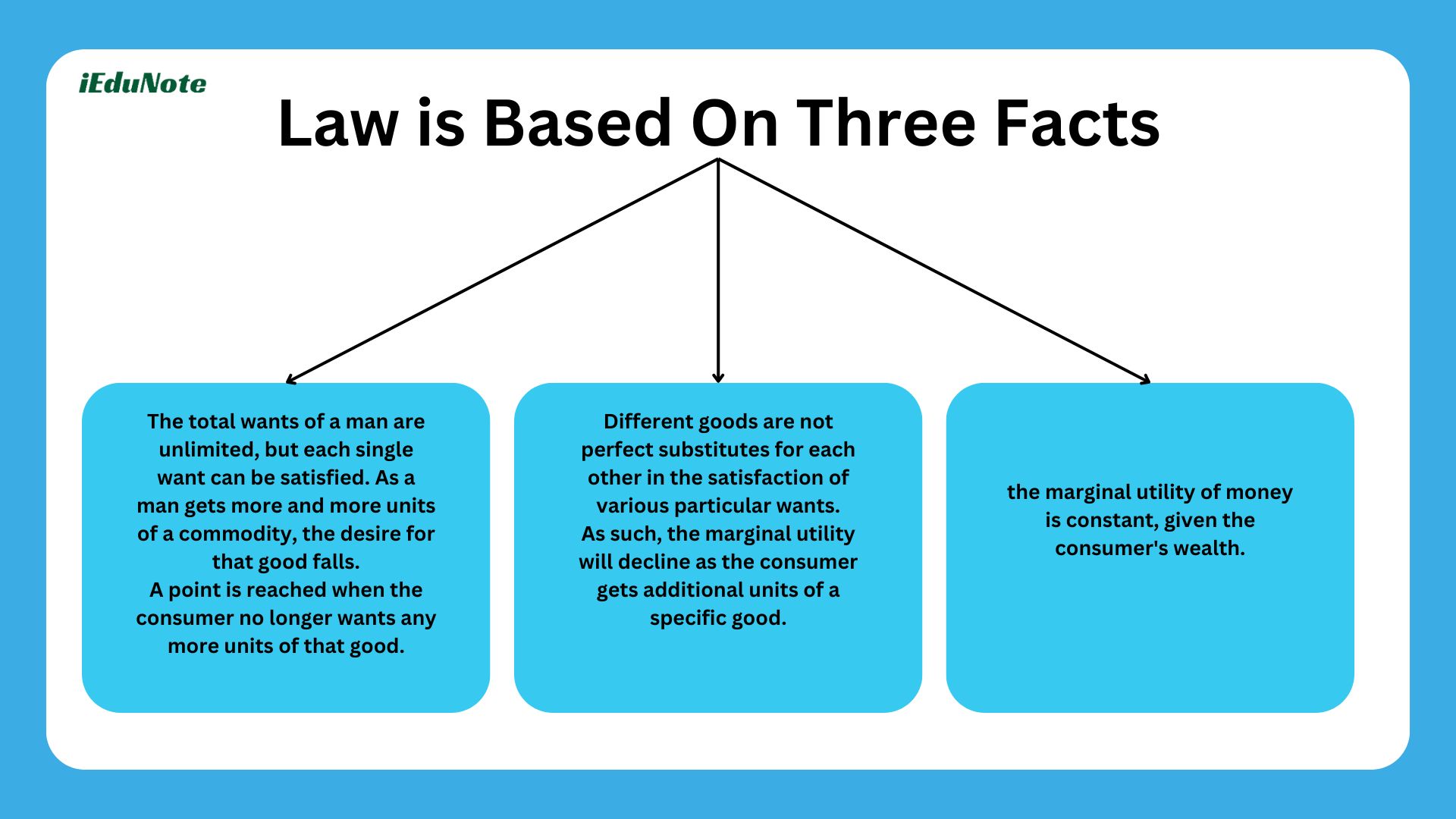
The law of diminishing marginal utility is based on three facts.
Firstly
The total wants of a man are unlimited, but each single want can be satisfied. As a man gets more and more units of a commodity, the desire for that good falls.
A point is reached when the consumer no longer wants any more units of that good.
Secondly
Different goods are not perfect substitutes for each other in the satisfaction of various particular wants.
As such, the marginal utility will decline as the consumer gets additional units of a specific good.
Thirdly
the marginal utility of money is constant, given the consumer’s wealth.
Explanation and Example of the Law of Diminishing Marginal Utility:

This law can be explained by taking a very simple example. Suppose a man is very thirsty. He goes to the market and buys one glass of water. The glass of water gives him immense pleasure, or we say the first glass of water has great utility for him.
If he takes a second glass of water after that, the utility will be less than that of the first one. It is because the edge of his thirst has been blunted to a great extent.
If he drinks a third glass of water, the utility of the third glass will be less than that of the second, and so on.
The utility goes on diminishing with the consumption of every successive glass of water until it drops down to zero. This is the point of satiety. It is the position of the consumer’s equilibrium or maximum satisfaction.
If the consumer is forced further to take a glass of water, it leads to disutility, causing total utility to decline. The marginal utility will become negative.
A rational consumer will stop taking water at the point at which marginal utility becomes negative, even if the good is free.
In short, the more we have of a thing, ceteris paribus, the less we want still more of that, or to be more precise:
“In a given period, the more of a specific product a consumer obtains, the less anxious he is to get more units of that product,” or we can say that as more units of a good are consumed, additional units will provide less additional satisfaction than previous units.
The following table and graph will make the law of diminishing marginal utility clearer.
Schedule of Law of Diminishing Marginal Utility
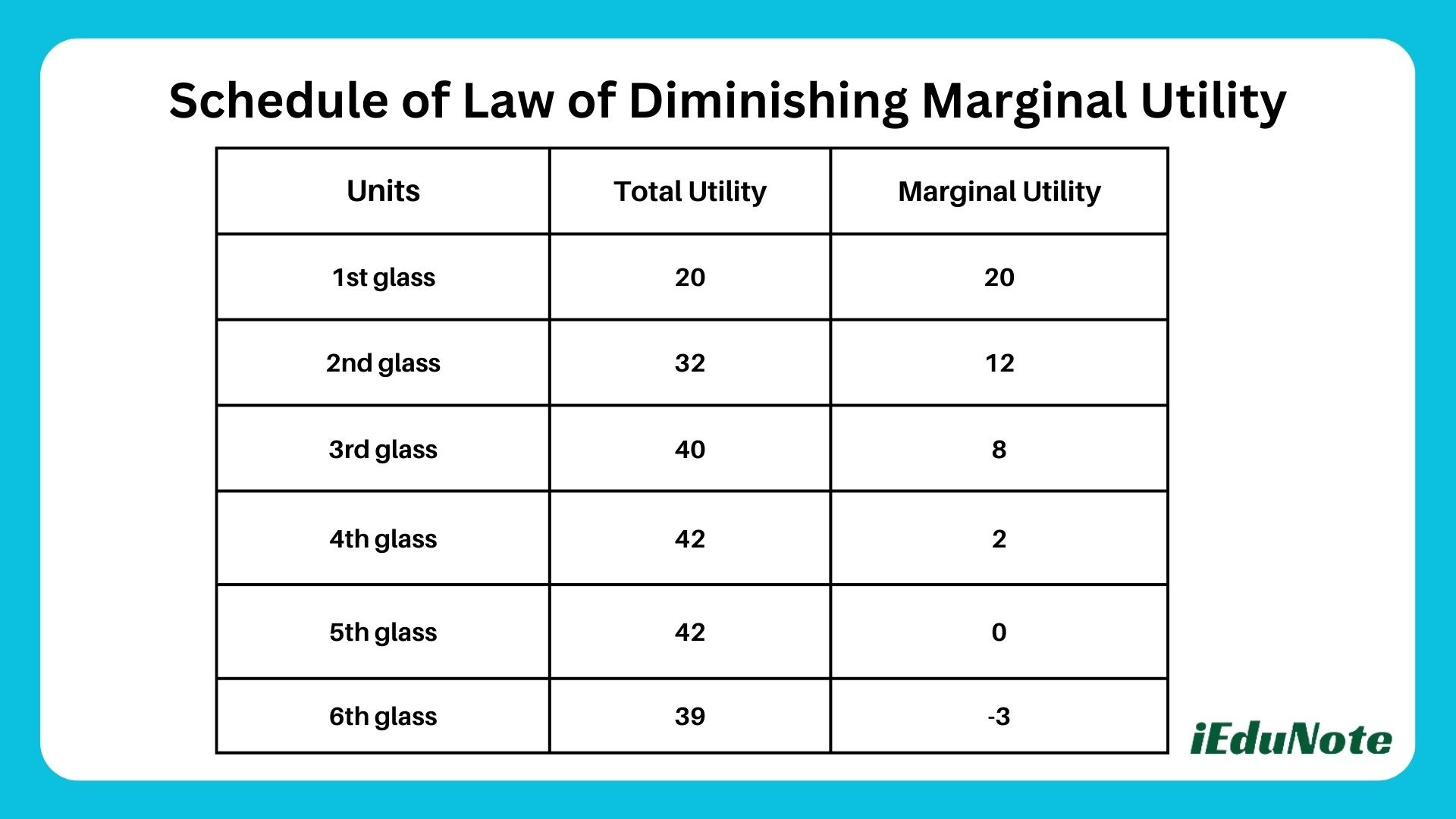
| Units | Total Utility | Marginal Utility |
| 1st glass | 20 | 20 |
| 2nd glass | 32 | 12 |
| 3rd glass | 40 | 8 |
| 4th glass | 42 | 2 |
| 5th glass | 42 | 0 |
| 6th glass | 39 | -3 |
From the above table, it is clear that in a given period, the first glass of water to a thirsty man gives 20 units of utility.
When he takes a second glass of water, the marginal utility goes down to 12 units; When he consumes a fifth glass of water, the marginal utility drops down to zero and if the consumption of water is forced further from this point the utility changes into disutility (-3).
Here it may be noted that the utility of the successive units consumed diminishes not because they are not inferior in quality to that of others.
We assume that all the units of a commodity consumed are exactly alike. The utility of the successive units falls simply because they happen to be consumed afterward.
Curve/Diagram of Law of Diminishing Marginal Utility:
Fhc law of diminishing marginal utility can also be represented by a diagram.
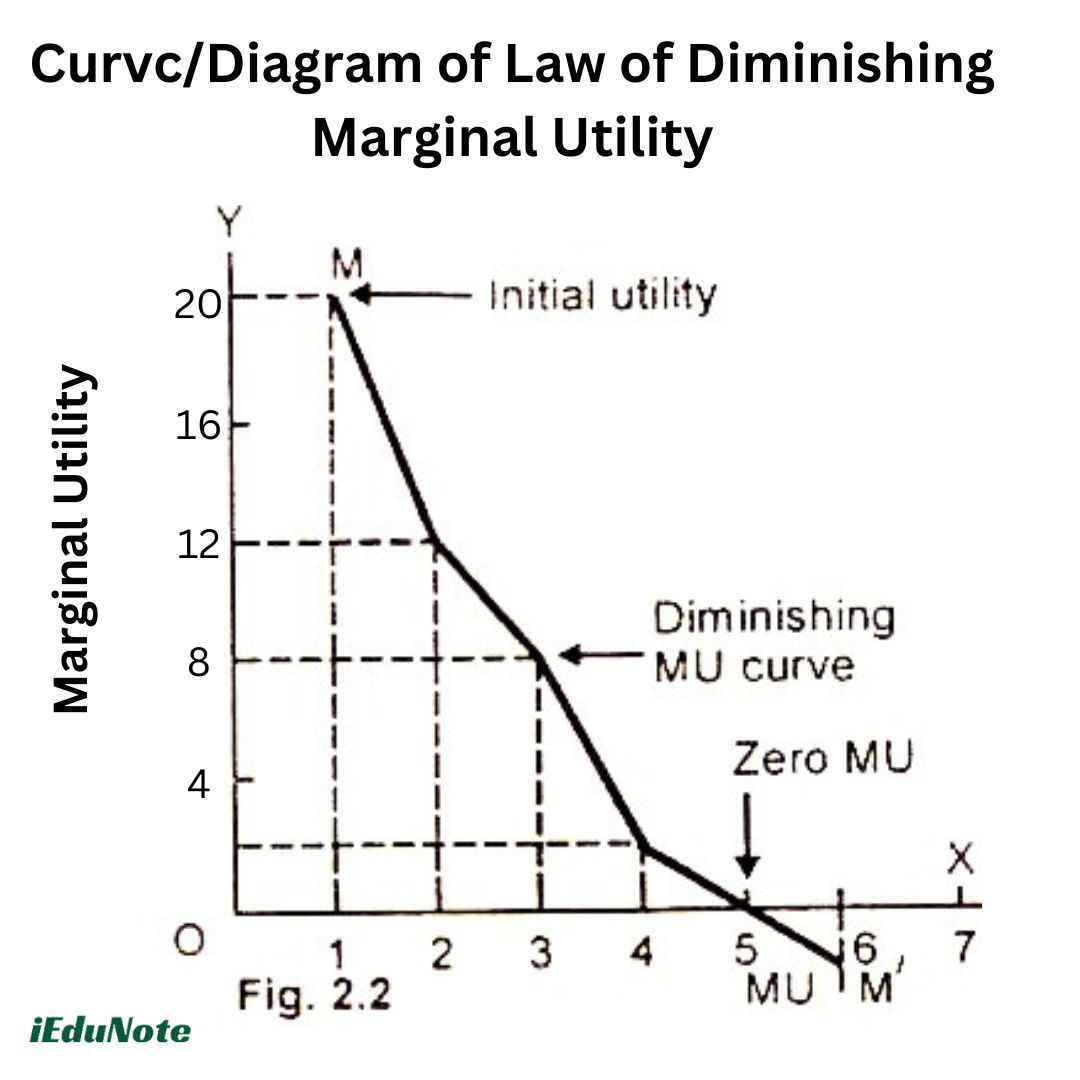
In Figure (2.2), along OX, we measure units of a commodity consumed and along OY is shown the marginal utility derived from them. The marginal utility of the first glass of water is called initial utility.
It is equal to 20 units. The MU of the 5th glass of water is zero. It is called the satiety point. The MU of the 6th glass of water is negative (-3). The MU curve here lies below the OX axis.
The utility curve MMZ falls left from left down to the right showing that the marginal utility of the successive units of glasses of water is falling.
Assumptions of the Law of Diminishing Marginal Utility:
(i) Rationality
In the cardinal utility analysis, it is assumed that the consumer is rational. He aims at the maximization of utility subject to the availability of his income.
(ii) Constant marginal utility of money
It is assumed in the theory that the marginal utility of money used for purchasing goods remains constant.
If the marginal utility of money changes with the increase or decrease in income, then it cannot yield the correct measurement of the marginal utility of the good.
(iii) Diminishing marginal utility
Another important assumption of utility analysis is that the utility gained from the successive units of a commodity diminishes in a given time.
(iv) Utility is additive
It is assumed that the utilities of different commodities are independent. The total utility of each commodity is additive.
(v) Consumption to be continuous
It is assumed in this law that the consumption of a commodity should be continuous. If there is an interval between the consumption of the same units of the commodity, the law may not hold good.
For instance, if you take one glass of water in the morning and the 2nd at noon, the marginal utility of the 2nd glass of water may increase.
(vi) Suitable quantity
It is also assumed that the commodity consumed is taken in suitable and reasonable units. If the units are too small, then the marginal utility instead of falling may increase up to a few units.
(vii) The character of the consumer does not change
The law holds if there is no change in the character of the consumer. For example, if a consumer develops a taste for wine, the additional units of wine may increase the marginal utility to a drunkard.
(viii) No change of fashion, customs, and tastes
If there is a sudden change in fashion or customs or the taste of a consumer, then the law will not operate.
(ix) No change in the price of the commodity
There should not be any change in the price of that commodity as more units are consumed.
Limitations/Exceptions of Law of Diminishing Marginal Utility:
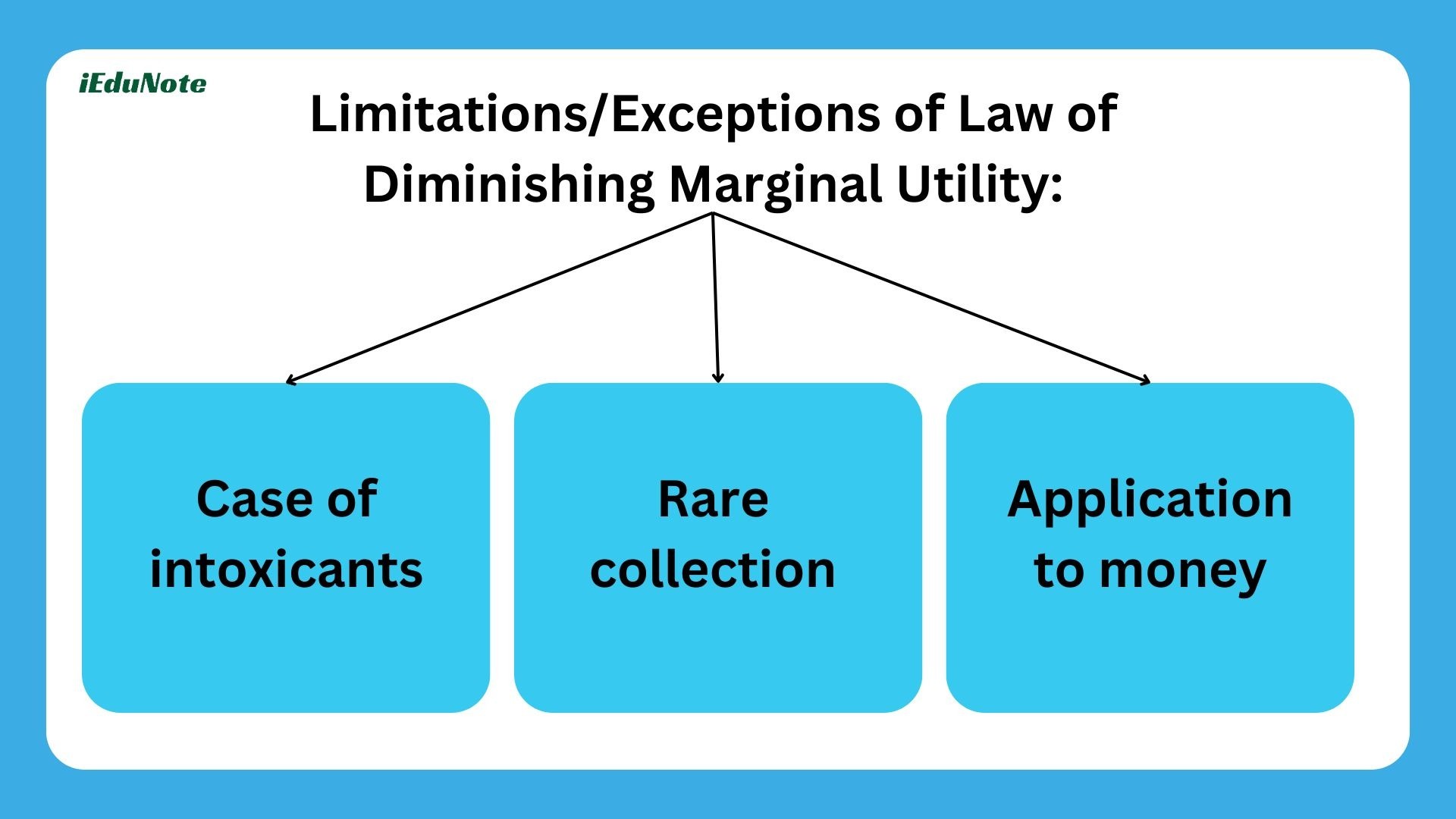
Case of intoxicants
Consumption of liquor defies the law for a short period. The more a person drinks, the more he likes it. However, this is truer only initially. A stage comes when a drunkard too starts taking less and less liquor and eventually stops it.
Rare collection
If there are only two diamonds in the world, the possession of the 2nd diamond will push up the marginal utility.
Application to money
The law equally holds good for money. It is true that the more money a man has, the greedier he is to get additional units of it. However, the truth is that the marginal utility of money declines with richness but never falls to zero.
Practical Importance of the Law of Diminishing Marginal Utility:
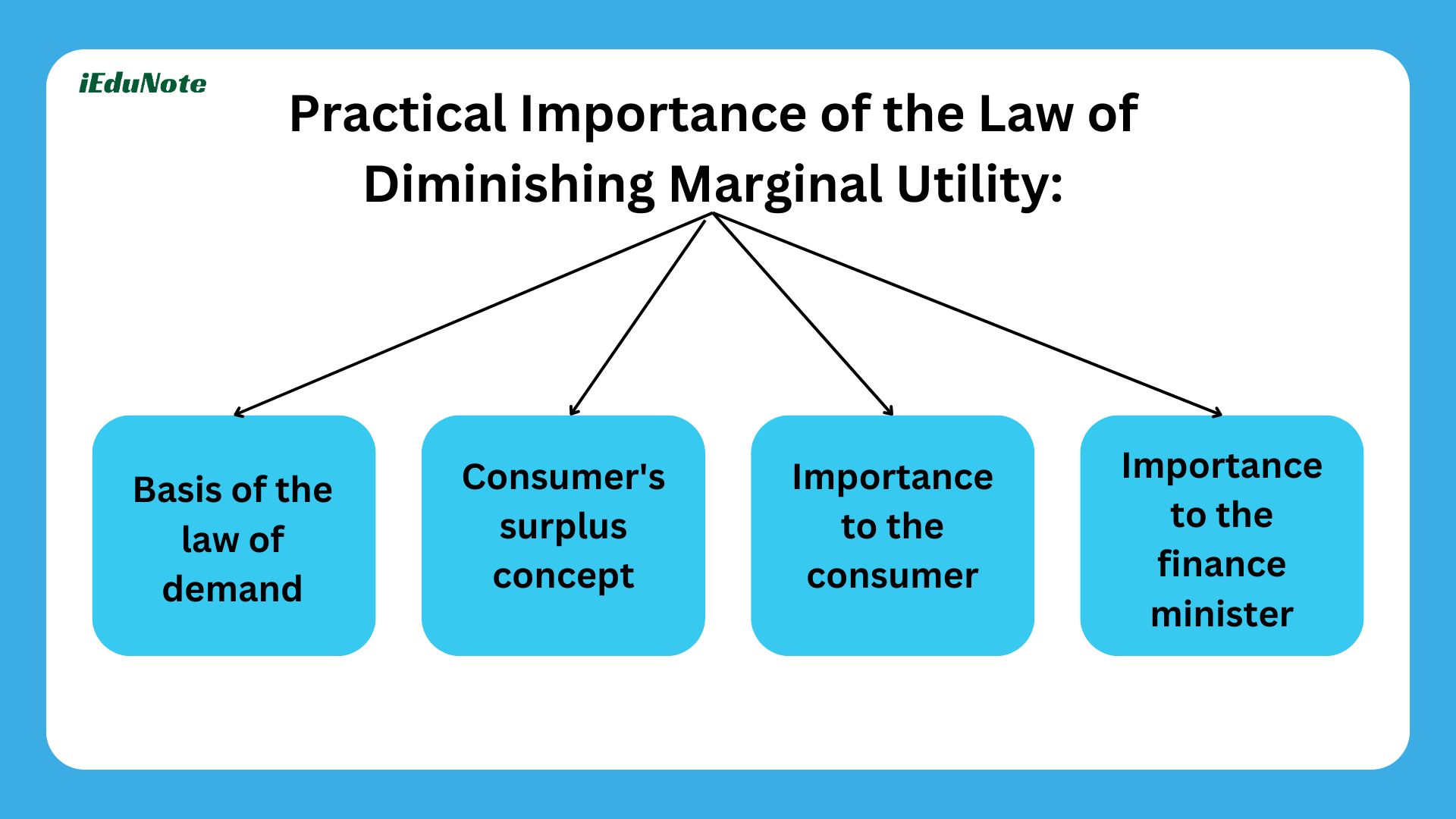
The law of diminishing marginal utility has great practical importance in economics. The law of demand, the theory of consumer surplus, and the equilibrium in the distribution of expenditure are derived from the law of diminishing marginal utility.
(i) Basis of the law of demand
The law of diminishing marginal utility and the law of demand are very closely related. They are both based on the premise that the more we have of a thing, the less we want additional increments of it.
In other words, we can say that as a person gets more and more of a particular commodity, the marginal utility of the successive units begins to diminish.
So every consumer, while buying a particular commodity, compares the marginal utility of the commodity and the price of the commodity that he has to pay.
If the marginal utility of the commodity is higher than that of the price, he purchases that commodity.
As he buys more and more, the marginal utility of the successive units begins to diminish. Then he pays less for the successive units.
He tries to equate at every step the marginal utility and the price of the commodity; he must lower its price so that consumers are induced to buy large quantities, and this is what is explained in the law of demand.
From this, we conclude that the law of demand and the law of diminishing returns are very closely interrelated.
(ii) Consumer’s surplus concept
The theory of consumer surplus is also based on the law of diminishing marginal utility. A consumer, while purchasing the commodity, compares the utility of the commodity with the price that he has to pay.
In most cases, he is willing to pay more than what he pays. The excess of the price that he would be willing to pay rather than going without the thing over that which he does pay is the economic measure of this surplus satisfaction.
It is, in fact, the difference between the total utility and the actual money spent.
(iii) Importance to the consumer
A consumer, to get the maximum satisfaction from his relatively scarce resources, distributes his income on commodities and services in such a way that the marginal utility from all the uses is the same.
Here again, the concept of marginal utility helps the consumer in arranging his scale of preference for the commodities and services.
(iv) Importance to the finance minister
Sometimes it is pointed out that the law of diminishing marginal utility does not apply to money. As a person accumulates more money, the desire to accumulate more money increases.
This view is superficial. Wealth is indeed acquired for the procurement of goods and services, and a person is always anxious to get more and more money.
But what is the utility of money to him? Is it not a fact that as a person gets more and more wealth, its utility progressively decreases, though it does not reach zero?
For example, a person who earns Tk 90,000 per month attaches less importance to Tk 10. But for a man who gets Tk 1000 per month, the value of Tk 10 to him is very high.
A finance minister knowing this fact that the utility of money to a rich man is high and to a poor man is low bases the system of taxation in such a way that rich persons are taxed at a progressive rate.
The system of modern taxation is, therefore, based on the law of diminishing marginal utility.
The law of diminishing marginal utility describes a familiar and fundamental tendency of human behavior. The law of diminishing marginal utility states, “As a consumer consumes more and more units of a specific commodity, the utility from the successive units goes on diminishing.”
Mr. H. Gossen, a German economist, was the first to explain this law in 1854. Alfred Marshall later restated this law in the following words: “The additional benefit which a person derives from an increase of his stock of a thing diminishes with every increase in the stock that already has.”
Law is based on Three Facts:

The law of diminishing marginal utility is based on three facts.
Firstly
The total wants of a man are unlimited, but each single want can be satisfied. As a man gets more and more units of a commodity, the desire for that good falls.
A point is reached when the consumer no longer wants any more units of that good.
Secondly
Different goods are not perfect substitutes for each other in the satisfaction of various particular wants.
As such, the marginal utility will decline as the consumer gets additional units of a specific good.
Thirdly
the marginal utility of money is constant, given the consumer’s wealth.
Explanation and Example of the Law of Diminishing Marginal Utility:

This law can be explained by taking a very simple example. Suppose a man is very thirsty. He goes to the market and buys one glass of water. The glass of water gives him immense pleasure, or we say the first glass of water has great utility for him.
If he takes a second glass of water after that, the utility will be less than that of the first one. It is because the edge of his thirst has been blunted to a great extent.
If he drinks a third glass of water, the utility of the third glass will be less than that of the second, and so on.
The utility goes on diminishing with the consumption of every successive glass of water until it drops down to zero. This is the point of satiety. It is the position of the consumer’s equilibrium or maximum satisfaction.
If the consumer is forced further to take a glass of water, it leads to disutility, causing total utility to decline. The marginal utility will become negative.
A rational consumer will stop taking water at the point at which marginal utility becomes negative, even if the good is free.
In short, the more we have of a thing, ceteris paribus, the less we want still more of that, or to be more precise:
“In a given period, the more of a specific product a consumer obtains, the less anxious he is to get more units of that product,” or we can say that as more units of a good are consumed, additional units will provide less additional satisfaction than previous units.
The following table and graph will make the law of diminishing marginal utility clearer.
Schedule of Law of Diminishing Marginal Utility

| Units | Total Utility | Marginal Utility |
| 1st glass | 20 | 20 |
| 2nd glass | 32 | 12 |
| 3rd glass | 40 | 8 |
| 4th glass | 42 | 2 |
| 5th glass | 42 | 0 |
| 6th glass | 39 | -3 |
From the above table, it is clear that in a given period, the first glass of water to a thirsty man gives 20 units of utility.
When he takes a second glass of water, the marginal utility goes down to 12 units; When he consumes a fifth glass of water, the marginal utility drops down to zero and if the consumption of water is forced further from this point the utility changes into disutility (-3).
Here it may be noted that the utility of the successive units consumed diminishes not because they are not inferior in quality to that of others.
We assume that all the units of a commodity consumed are exactly alike. The utility of the successive units falls simply because they happen to be consumed afterward.
Curve/Diagram of Law of Diminishing Marginal Utility:
Fhc law of diminishing marginal utility can also be represented by a diagram.

In Figure (2.2), along OX, we measure units of a commodity consumed and along OY is shown the marginal utility derived from them. The marginal utility of the first glass of water is called initial utility.
It is equal to 20 units. The MU of the 5th glass of water is zero. It is called the satiety point. The MU of the 6th glass of water is negative (-3). The MU curve here lies below the OX axis.
The utility curve MMZ falls left from left down to the right showing that the marginal utility of the successive units of glasses of water is falling.
Assumptions of the Law of Diminishing Marginal Utility:
(i) Rationality
In the cardinal utility analysis, it is assumed that the consumer is rational. He aims at the maximization of utility subject to the availability of his income.
(ii) Constant marginal utility of money
It is assumed in the theory that the marginal utility of money used for purchasing goods remains constant.
If the marginal utility of money changes with the increase or decrease in income, then it cannot yield the correct measurement of the marginal utility of the good.
(iii) Diminishing marginal utility
Another important assumption of utility analysis is that the utility gained from the successive units of a commodity diminishes in a given time.
(iv) Utility is additive
It is assumed that the utilities of different commodities are independent. The total utility of each commodity is additive.
(v) Consumption to be continuous
It is assumed in this law that the consumption of a commodity should be continuous. If there is an interval between the consumption of the same units of the commodity, the law may not hold good.
For instance, if you take one glass of water in the morning and the 2nd at noon, the marginal utility of the 2nd glass of water may increase.
(vi) Suitable quantity
It is also assumed that the commodity consumed is taken in suitable and reasonable units. If the units are too small, then the marginal utility instead of falling may increase up to a few units.
(vii) The character of the consumer does not change
The law holds if there is no change in the character of the consumer. For example, if a consumer develops a taste for wine, the additional units of wine may increase the marginal utility to a drunkard.
(viii) No change of fashion, customs, and tastes
If there is a sudden change in fashion or customs or the taste of a consumer, then the law will not operate.
(ix) No change in the price of the commodity
There should not be any change in the price of that commodity as more units are consumed.
Limitations/Exceptions of Law of Diminishing Marginal Utility:

Case of intoxicants
Consumption of liquor defies the law for a short period. The more a person drinks, the more he likes it. However, this is truer only initially. A stage comes when a drunkard too starts taking less and less liquor and eventually stops it.
Rare collection
If there are only two diamonds in the world, the possession of the 2nd diamond will push up the marginal utility.
Application to money
The law equally holds good for money. It is true that the more money a man has, the greedier he is to get additional units of it. However, the truth is that the marginal utility of money declines with richness but never falls to zero.
Practical Importance of the Law of Diminishing Marginal Utility:

The law of diminishing marginal utility has great practical importance in economics. The law of demand, the theory of consumer surplus, and the equilibrium in the distribution of expenditure are derived from the law of diminishing marginal utility.
(i) Basis of the law of demand
The law of diminishing marginal utility and the law of demand are very closely related. They are both based on the premise that the more we have of a thing, the less we want additional increments of it.
In other words, we can say that as a person gets more and more of a particular commodity, the marginal utility of the successive units begins to diminish.
So every consumer, while buying a particular commodity, compares the marginal utility of the commodity and the price of the commodity that he has to pay.
If the marginal utility of the commodity is higher than that of the price, he purchases that commodity.
As he buys more and more, the marginal utility of the successive units begins to diminish. Then he pays less for the successive units.
He tries to equate at every step the marginal utility and the price of the commodity; he must lower its price so that consumers are induced to buy large quantities, and this is what is explained in the law of demand.
From this, we conclude that the law of demand and the law of diminishing returns are very closely interrelated.
(ii) Consumer’s surplus concept
The theory of consumer surplus is also based on the law of diminishing marginal utility. A consumer, while purchasing the commodity, compares the utility of the commodity with the price that he has to pay.
In most cases, he is willing to pay more than what he pays. The excess of the price that he would be willing to pay rather than going without the thing over that which he does pay is the economic measure of this surplus satisfaction.
It is, in fact, the difference between the total utility and the actual money spent.
(iii) Importance to the consumer
A consumer, to get the maximum satisfaction from his relatively scarce resources, distributes his income on commodities and services in such a way that the marginal utility from all the uses is the same.
Here again, the concept of marginal utility helps the consumer in arranging his scale of preference for the commodities and services.
(iv) Importance to the finance minister
Sometimes it is pointed out that the law of diminishing marginal utility does not apply to money. As a person accumulates more money, the desire to accumulate more money increases.
This view is superficial. Wealth is indeed acquired for the procurement of goods and services, and a person is always anxious to get more and more money.
But what is the utility of money to him? Is it not a fact that as a person gets more and more wealth, its utility progressively decreases, though it does not reach zero?
For example, a person who earns $90,000 per month attaches less importance to $10. But for a man who gets $1000 per month, the value of Tk 10 to him is very high.
A finance minister knowing this fact that the utility of money to a rich man is high and to a poor man is low bases the system of taxation in such a way that rich persons are taxed at a progressive rate.
The system of modern taxation is, therefore, based on the law of diminishing marginal utility.